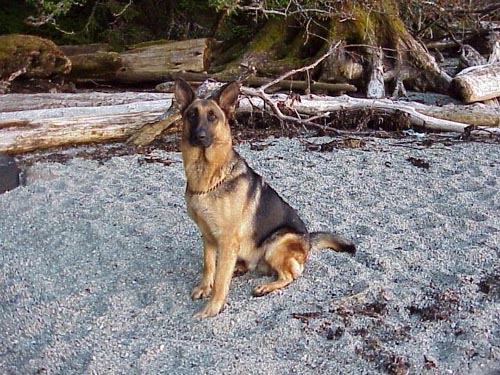 Pet Talk - Pet Health by Dr. Fran Good, DVM June 20, 2003
Not to worry.  Photo by Penny Eubanks ©2003
But how to find them, if you really need to know how heavy a load of the little critters you're dealing with. It doesn't really matter, as you're going to do the same thing, regardless, but at least you'll know what to look for. First, flip Cosmo on his back. Like any self-respecting Lab, Cosmo is now in seventh heaven. 'Ooh, baby, belly rubs, what I live for!' While you're rubbing Cosmo's belly with one hand, to keep him happily on his back, use your other hand to riffle his fur backwards, against the grain. If you've got a lot of fleas, you may see a little brown bug, light brown, almost reddish, about 2 mm long, running for cover. It's going to be long and thin, with a hard shell covering and six little legs sticking straight underneath it. Unless you have a heavy infestation, or a really good eye, you may not see them, your first time looking. I can spot them pretty easily, as can any veterinarian, but we know what we're looking for. We've seen millions of 'em. But don't despair. Unlike most things that inhabit the skin, fleas leave visible traces of their presence. Fleas are bloodsuckers, that's what they eat, what sustains them. If you could see them eating microscopically, you'd see them inset their mouthparts under the skin of your pet, inject a little of their saliva to keep the blood from clotting - this is where the allergic animals get their start - and then suck up their blood meal. Once they've ingested what they need from Cosmo's blood, they then excrete stuff that looks like specks of dirt. And that's what we call it. Flea dirt. This is what falls off the animal and sustains all the hatching larvae in the environment. You can tell flea dirt apart from regular dirt by brushing some of the 'dirt' out of Cosmo's hair, putting it onto a white sheet of paper, or paper toweling, and then dripping a drop of water on it. With your finger, streak out the piece of dirt. If it streaks out brown, like a piece of dirt, then that's what it is. Dirt, real dirt, the stuff you grow your flowers in. If that's all you find, wash your dog, treat him for fleas to make sure that not what's causing the itching, and continue your search for causative itching agents. If on the other hand, when you streak out the piece of dirt, it streaks out red, like blood, then that's what it is. Blood. Cosmo's blood. Treat him for fleas, treat your house for fleas, and see if the itching stops after a week or two. If so - and that's going to be most of you - you're done. Congratulations. Have a nice summer. For those of you that still have an itchy Cosmo on your hands, we'll continue the search. But before we do that, I have to answer all the questions I can hear coming rolling back to me. What do I treat Cosmo with to get rid of the fleas? Why do I have to treat my house? When will this be over? That's next: How to be rid of fleas...
E-mail your comments
Post a Comment -------View Comments
|